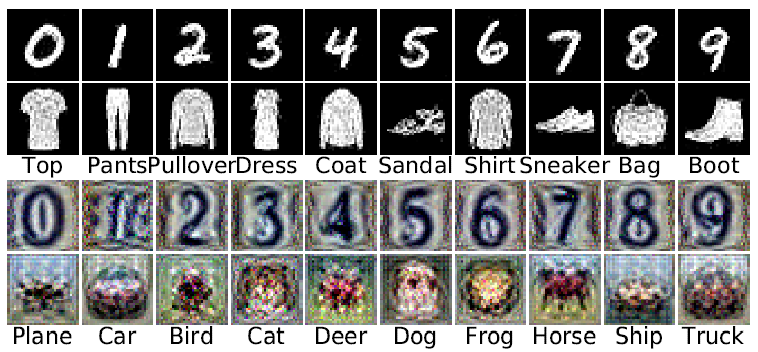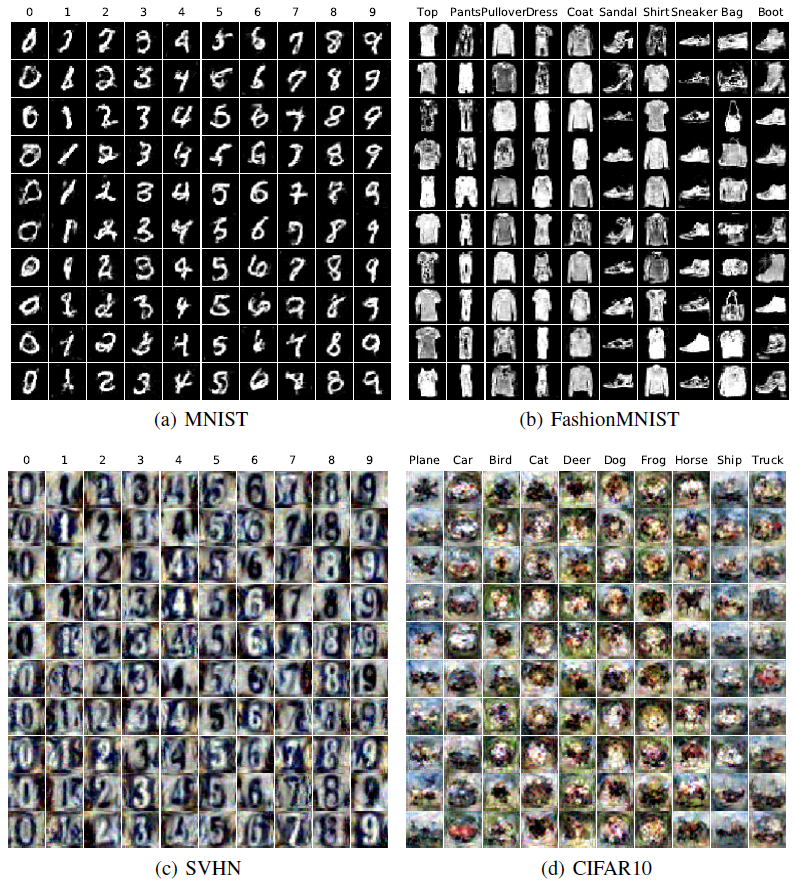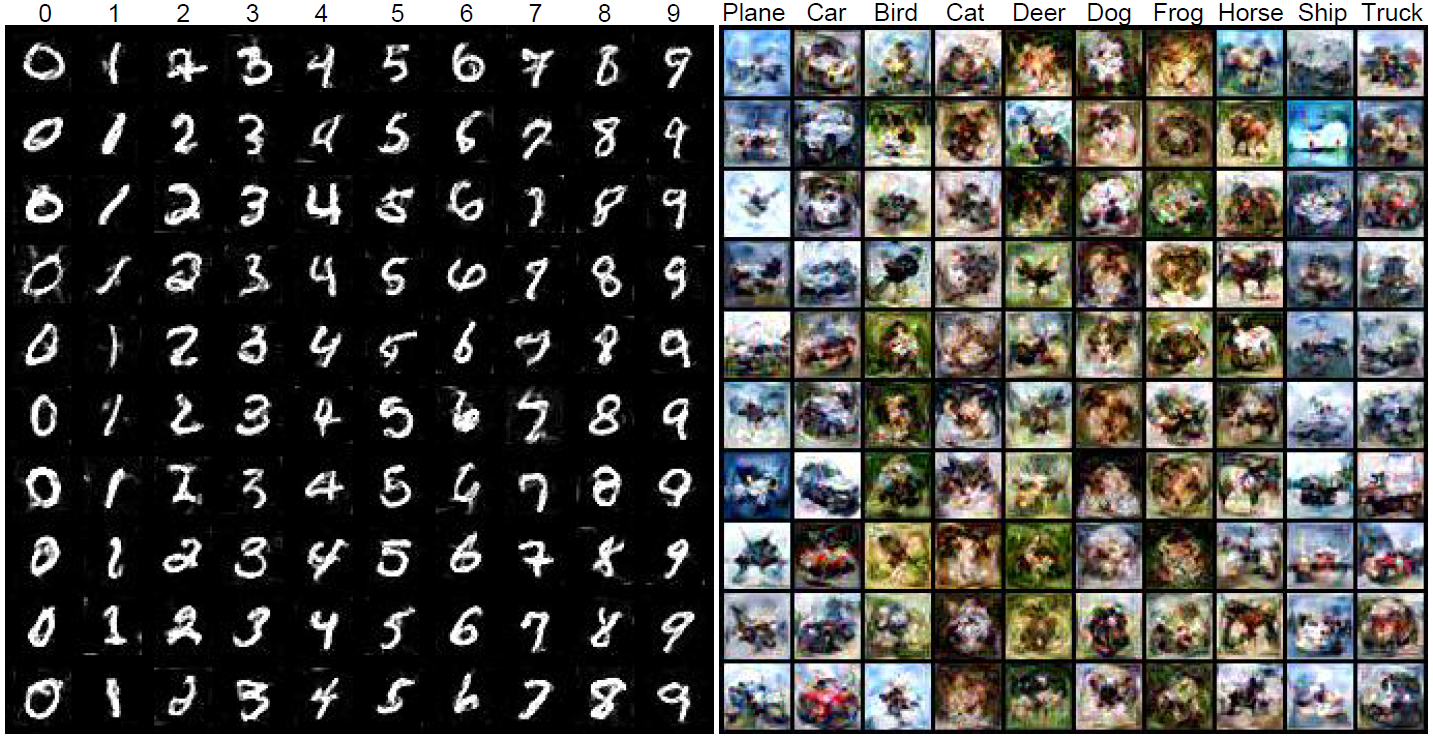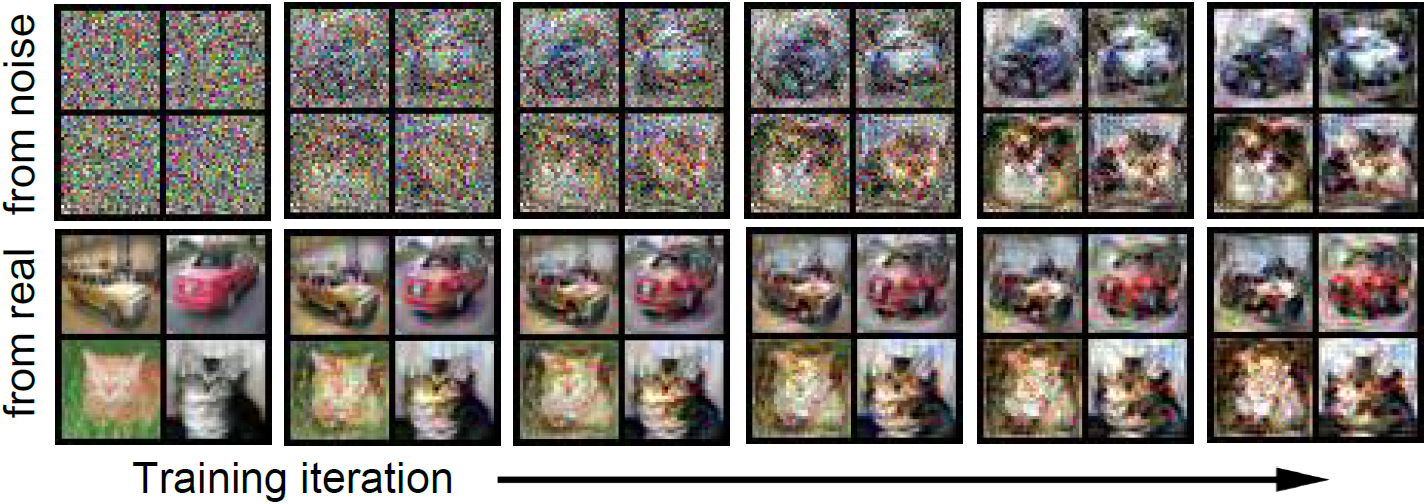Dataset condensation aims to condense a large training set T into a small synthetic set S such that the model trained on the small synthetic set can obtain comparable testing performance to that trained on the large training set.
This repository includes codes for Dataset Condensation with Gradient Matching (ICLR 2021 Oral) and Dataset Condensation with Differentiable Siamese Augmentation (ICML 2021).
Off-the-shelf synthetic sets can be downloaded from Google Drive. Each .pt file includes 5 synthetic sets learned with ConvNet in 5 independent experiments and corresponding 100 testing accuracies. Note that these synthetic data have been normalized.
Dataset Condensation with Gradient Matching [PDF]
install packages in the requirements.
python main.py --dataset CIFAR10 --model ConvNet --ipc 10
# --dataset: MNIST, FashionMNIST, SVHN, CIFAR10, CIFAR100
# --ipc (images/class): 1, 10, 20, 30, 40, 50
python main.py --dataset MNIST --model ConvNet --ipc 1 --eval_mode M
# --model: MLP, LeNet, ConvNet, AlexNet, VGG11BN, ResNet18BN_AP, Note: set --lr_img 0.01 when --model MLP
python main.py --dataset MNIST --model ConvNetW32 --eval_mode W --ipc 1
python main.py --dataset MNIST --model ConvNetW64 --eval_mode W --ipc 1
python main.py --dataset MNIST --model ConvNetW128 --eval_mode W --ipc 1
python main.py --dataset MNIST --model ConvNetW256 --eval_mode W --ipc 1
python main.py --dataset MNIST --model ConvNetD1 --eval_mode D --ipc 1
python main.py --dataset MNIST --model ConvNetD2 --eval_mode D --ipc 1
python main.py --dataset MNIST --model ConvNetD3 --eval_mode D --ipc 1
python main.py --dataset MNIST --model ConvNetD4 --eval_mode D --ipc 1
python main.py --dataset MNIST --model ConvNetAS --eval_mode A --ipc 1
python main.py --dataset MNIST --model ConvNetAR --eval_mode A --ipc 1
python main.py --dataset MNIST --model ConvNetAL --eval_mode A --ipc 1
python main.py --dataset MNIST --model ConvNetNP --eval_mode P --ipc 1
python main.py --dataset MNIST --model ConvNetMP --eval_mode P --ipc 1
python main.py --dataset MNIST --model ConvNetAP --eval_mode P --ipc 1
python main.py --dataset MNIST --model ConvNetNN --eval_mode N --ipc 1
python main.py --dataset MNIST --model ConvNetBN --eval_mode N --ipc 1
python main.py --dataset MNIST --model ConvNetLN --eval_mode N --ipc 1
python main.py --dataset MNIST --model ConvNetIN --eval_mode N --ipc 1
python main.py --dataset MNIST --model ConvNetGN --eval_mode N --ipc 1
python main.py --dataset MNIST --model ConvNet --ipc 1 --dis_metric mse
# --dis_metric (gradient distance metrics): ours, mse, cos
# --model: MLP, LeNet, ConvNet, AlexNet, VGG11BN, ResNet18BN_AP
| MNIST | FashionMNIST | SVHN | CIFAR10 | CIFAR100 | |
|---|---|---|---|---|---|
| 1 img/cls | 91.7 | 70.5 | 31.2 | 28.3 | 12.8 |
| 10 img/cls | 97.4 | 82.3 | 76.1 | 44.9 | 25.2 |
| 50 img/cls | 98.8 | 83.6 | 82.3 | 53.9 | - |
Table 1: Testing accuracies (%) of ConvNets trained from scratch on 1, 10 or 50 synthetic image(s)/class.
Figure 2: Visualization of condensed 1 image/class with ConvNet for MNIST, FashionMNIST, SVHN and CIFAR10. Average testing accuracies on randomly initialized ConvNets are 91.7%, 70.5%, 31.2% and 28.3% respectively.Figure 3: Visualization of condensed 10 images/class with ConvNet for MNIST, FashionMNIST, SVHN and CIFAR10. Average testing accuracies on randomly initialized ConvNets are 97.4%, 82.3%, 76.1% and 44.9% respectively.
@inproceedings{
zhao2021DC,
title={Dataset Condensation with Gradient Matching},
author={Zhao, Bo and Mopuri, Konda Reddy and Bilen, Hakan},
booktitle={International Conference on Learning Representations},
year={2021},
url={https://openreview.net/forum?id=mSAKhLYLSsl}
}
Dataset Condensation with Differentiable Siamese Augmentation [PDF]
install packages in the requirements.
python main.py --dataset CIFAR10 --model ConvNet --ipc 10 --init real --method DSA --dsa_strategy color_crop_cutout_flip_scale_rotate
# --dataset: MNIST, FashionMNIST, SVHN, CIFAR10, CIFAR100
# --ipc (images/class): 1, 10, 20, 30, 40, 50
# note: use color_crop_cutout_flip_scale_rotate for FashionMNIST CIFAR10/100, and color_crop_cutout_scale_rotate for the digit datasets (MNIST and SVHN), as flip augmentation is not good for digit datasets.
python main.py --dataset CIFAR10 --model ConvNet --ipc 10 --init real --method DSA --dsa_strategy crop
# --dataset: MNIST, FashionMNIST, SVHN, CIFAR10
# --dsa_strategy: color, crop, cutout, flip, scale, rotate, color_crop_cutout_scale_rotate, color_crop_cutout_flip_scale_rotate
# note: flip augmentation is not good for digit datasets (MNIST and SVHN).
| MNIST | FashionMNIST | SVHN | CIFAR10 | CIFAR100 | |
|---|---|---|---|---|---|
| 1 img/cls | 88.7 | 70.6 | 27.5 | 28.8 | 13.9 |
| 10 img/cls | 97.8 | 84.6 | 79.2 | 52.1 | 32.3 |
| 50 img/cls | 99.2 | 88.7 | 84.4 | 60.6 | - |
Table 2: Testing accuracies (%) of ConvNets trained from scratch on 1, 10 or 50 synthetic image(s)/class.
Figure 5: Visualization of the generated 10 images/class synthetic sets of MINIST and CIFAR10. Average testing accuracies on randomly initialized ConvNets are 97.8% and 52.1% respectively.Figure 6: The learning/rendering process of two classes in CIFAR10 initialized from random noise and real images respectively.
@inproceedings{
zhao2021DSA,
title={Dataset Condensation with Differentiable Siamese Augmentation},
author={Zhao, Bo and Bilen, Hakan},
booktitle={International Conference on Machine Learning},
year={2021}
}





